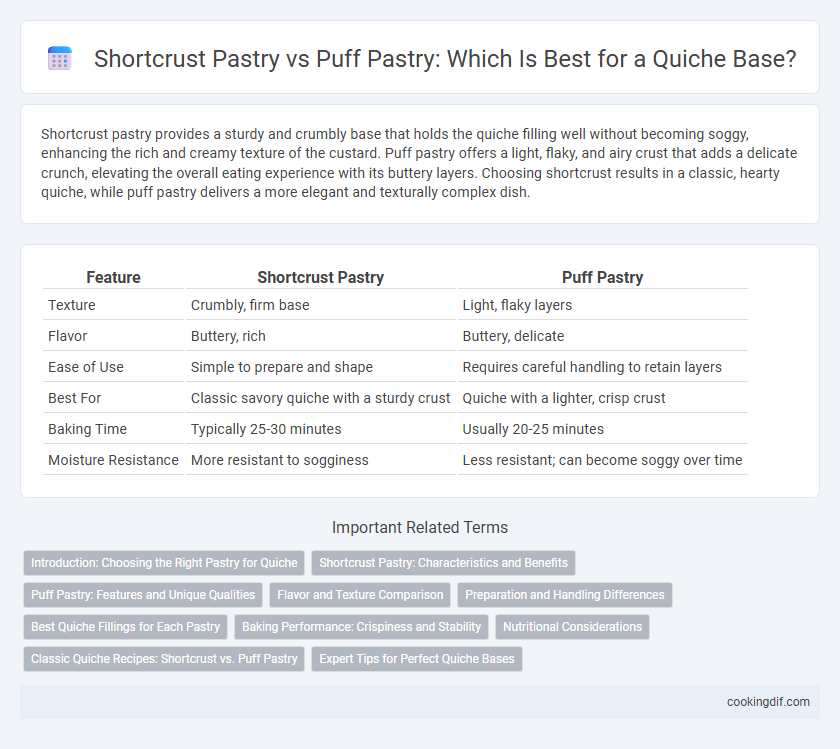Shortcrust pastry provides a sturdy and crumbly base that holds the quiche filling well without becoming soggy, enhancing the rich and creamy texture of the custard. Puff pastry offers a light, flaky, and airy crust that adds a delicate crunch, elevating the overall eating experience with its buttery layers. Choosing shortcrust results in a classic, hearty quiche, while puff pastry delivers a more elegant and texturally complex dish.
Table of Comparison
| Feature | Shortcrust Pastry | Puff Pastry |
|---|---|---|
| Texture | Crumbly, firm base | Light, flaky layers |
| Flavor | Buttery, rich | Buttery, delicate |
| Ease of Use | Simple to prepare and shape | Requires careful handling to retain layers |
| Best For | Classic savory quiche with a sturdy crust | Quiche with a lighter, crisp crust |
| Baking Time | Typically 25-30 minutes | Usually 20-25 minutes |
| Moisture Resistance | More resistant to sogginess | Less resistant; can become soggy over time |
Introduction: Choosing the Right Pastry for Quiche
Shortcrust pastry, known for its crumbly and buttery texture, provides a sturdy and rich base ideal for holding the savory fillings of a quiche without becoming soggy. Puff pastry offers a delicate, flaky, and airy layer but can overpower the quiche's flavors due to its lightness and tendency to rise excessively during baking. Selecting shortcrust pastry enhances structural integrity and complements the quiche's creamy texture, making it the preferred choice for classic quiche recipes.
Shortcrust Pastry: Characteristics and Benefits
Shortcrust pastry provides a sturdy, crumbly base ideal for quiche, offering excellent support for rich fillings without becoming soggy. Its higher fat content and lower rise create a tender, buttery texture that contrasts well with creamy egg mixtures. This pastry's simplicity and ability to hold savory ingredients make it a preferred choice for traditional quiche recipes.
Puff Pastry: Features and Unique Qualities
Puff pastry offers a light, flaky texture that contrasts with the dense, crumbly nature of shortcrust pastry, creating a more delicate quiche base. Its multiple butter layers provide an airy rise and a buttery crispness that enhances the overall mouthfeel and visual appeal. Puff pastry's unique ability to puff up during baking locks in fillings, resulting in a perfectly structured quiche with a golden, textured crust.
Flavor and Texture Comparison
Shortcrust pastry provides a buttery, crumbly texture ideal for quiche bases, offering a rich, savory flavor that complements creamy fillings. Puff pastry delivers a light, flaky, and airy texture, adding a delicate crispiness but with a more neutral flavor that may overshadow the quiche ingredients. Choosing shortcrust enhances the quiche's hearty mouthfeel, while puff pastry focuses on a layered crunch and visual appeal.
Preparation and Handling Differences
Shortcrust pastry offers a sturdy, crumbly base ideal for supporting the rich fillings of a quiche without becoming soggy, requiring careful handling to avoid overworking the dough which can lead to toughness. Puff pastry creates a light, flaky crust through its multiple layers of butter and dough, demanding precise rolling and chilling to maintain its delicate structure and achieve optimal rise during baking. Preparation of shortcrust involves minimal folding to retain tenderness, while puff pastry requires repeated rolling and folding to develop its characteristic laminated texture.
Best Quiche Fillings for Each Pastry
Shortcrust pastry provides a sturdy, buttery base ideal for rich quiche fillings like bacon and gruyere or spinach and goat cheese, as it holds moisture well without becoming soggy. Puff pastry's light, flaky texture complements lighter fillings such as smoked salmon with dill or asparagus and ricotta, adding an elegant crispness that balances delicate flavors. Choosing the right pastry enhances texture contrast and elevates the overall taste experience of each quiche variation.
Baking Performance: Crispiness and Stability
Shortcrust pastry provides a firm and stable base for quiche, maintaining crispiness without excessive shrinkage during baking. Puff pastry offers a lighter, flakier texture but may become soggy under moist fillings and is prone to rising unevenly. For optimal baking performance, shortcrust ensures consistent crispiness and structural integrity essential for quiche.
Nutritional Considerations
Shortcrust pastry for quiche typically contains higher fat content due to butter or lard, contributing to a richer calorie profile compared to puff pastry. Puff pastry, layered with butter, tends to have more saturated fat but offers a lighter, flakier texture with slightly fewer calories per serving. Choosing between shortcrust and puff pastry impacts the overall nutritional balance, influencing fat types, calorie density, and gluten content in a quiche base.
Classic Quiche Recipes: Shortcrust vs. Puff Pastry
Shortcrust pastry offers a firm, crumbly texture ideal for classic quiche recipes, providing a sturdy base that holds rich custard fillings without becoming soggy. Puff pastry, by contrast, delivers a lighter, flaky crust that adds a delicate crispness but may lack the structural support needed for denser quiche ingredients. Choosing shortcrust pastry ensures traditional quiches maintain their authentic texture, while puff pastry suits variations requiring a more airy, buttery foundation.
Expert Tips for Perfect Quiche Bases
Shortcrust pastry offers a tender, crumbly texture that supports rich quiche fillings without becoming soggy, making it a top choice for classic quiches. Puff pastry provides a light, flaky crust with multiple buttery layers that add a delicate crunch but can sometimes overshadow subtle filling flavors. Expert tips emphasize blind baking shortcrust for a crisp base and chilling dough before baking puff pastry to ensure optimal rise and flakiness.
Shortcrust pastry vs puff pastry for quiche base Infographic

 cookingdif.com
cookingdif.com